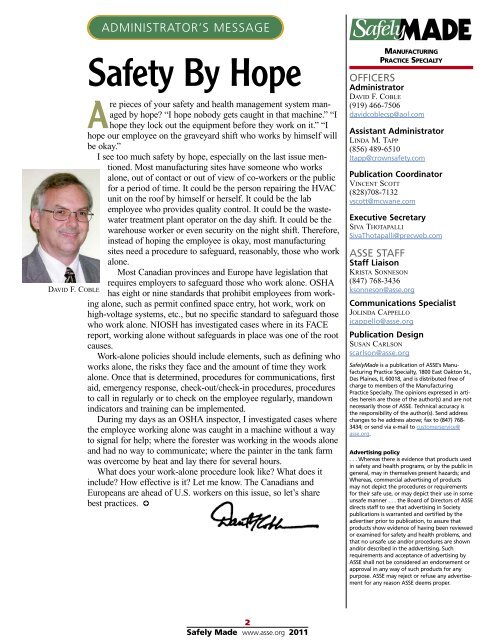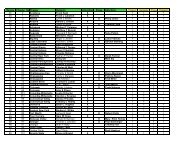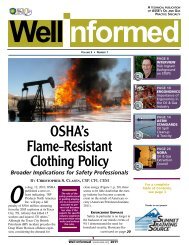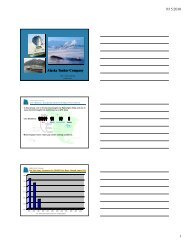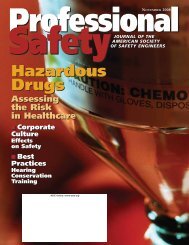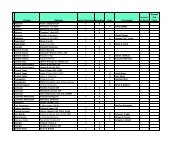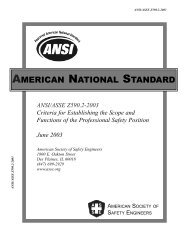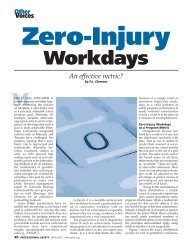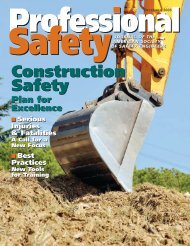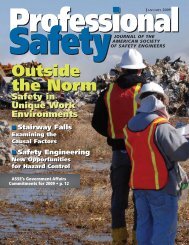Safety & Health Effects of Shift Work - ASSE Members
Safety & Health Effects of Shift Work - ASSE Members
Safety & Health Effects of Shift Work - ASSE Members
Create successful ePaper yourself
Turn your PDF publications into a flip-book with our unique Google optimized e-Paper software.
ADMINISTRATOR’S MESSAGE<br />
<strong>Safety</strong> By Hope<br />
Are pieces <strong>of</strong> your safety and health management system managed<br />
by hope “I hope nobody gets caught in that machine.” “I<br />
hope they lock out the equipment before they work on it.” “I<br />
hope our employee on the graveyard shift who works by himself will<br />
be okay.”<br />
I see too much safety by hope, especially on the last issue mentioned.<br />
Most manufacturing sites have someone who works<br />
alone, out <strong>of</strong> contact or out <strong>of</strong> view <strong>of</strong> co-workers or the public<br />
for a period <strong>of</strong> time. It could be the person repairing the HVAC<br />
unit on the ro<strong>of</strong> by himself or herself. It could be the lab<br />
employee who provides quality control. It could be the wastewater<br />
treatment plant operator on the day shift. It could be the<br />
warehouse worker or even security on the night shift. Therefore,<br />
instead <strong>of</strong> hoping the employee is okay, most manufacturing<br />
sites need a procedure to safeguard, reasonably, those who work<br />
alone.<br />
Most Canadian provinces and Europe have legislation that<br />
requires employers to safeguard those who work alone. OSHA<br />
DAVID F. COBLE<br />
has eight or nine standards that prohibit employees from working<br />
alone, such as permit confined space entry, hot work, work on<br />
high-voltage systems, etc., but no specific standard to safeguard those<br />
who work alone. NIOSH has investigated cases where in its FACE<br />
report, working alone without safeguards in place was one <strong>of</strong> the root<br />
causes.<br />
<strong>Work</strong>-alone policies should include elements, such as defining who<br />
works alone, the risks they face and the amount <strong>of</strong> time they work<br />
alone. Once that is determined, procedures for communications, first<br />
aid, emergency response, check-out/check-in procedures, procedures<br />
to call in regularly or to check on the employee regularly, mandown<br />
indicators and training can be implemented.<br />
During my days as an OSHA inspector, I investigated cases where<br />
the employee working alone was caught in a machine without a way<br />
to signal for help; where the forester was working in the woods alone<br />
and had no way to communicate; where the painter in the tank farm<br />
was overcome by heat and lay there for several hours.<br />
What does your work-alone procedure look like What does it<br />
include How effective is it Let me know. The Canadians and<br />
Europeans are ahead <strong>of</strong> U.S. workers on this issue, so let’s share<br />
best practices. <br />
Safely MADE<br />
MANUFACTURING<br />
PRACTICE SPECIALTY<br />
OFFICERS<br />
Administrator<br />
DAVID F. COBLE<br />
(919) 466-7506<br />
davidcoblecsp@aol.com<br />
Assistant Administrator<br />
LINDA M. TAPP<br />
(856) 489-6510<br />
ltapp@crownsafety.com<br />
Publication Coordinator<br />
VINCENT SCOTT<br />
(828)708-7132<br />
vscott@mcwane.com<br />
Executive Secretary<br />
SIVA THOTAPALLI<br />
SivaThotapalli@precweb.com<br />
<strong>ASSE</strong> STAFF<br />
Staff Liaison<br />
KRISTA SONNESON<br />
(847) 768-3436<br />
ksonneson@asse.org<br />
Communications Specialist<br />
JOLINDA CAPPELLO<br />
jcappello@asse.org<br />
Publication Design<br />
SUSAN CARLSON<br />
scarlson@asse.org<br />
SafelyMade is a publication <strong>of</strong> <strong>ASSE</strong>’s Manufacturing<br />
Practice Specialty, 1800 East Oakton St.,<br />
Des Plaines, IL 60018, and is distributed free <strong>of</strong><br />
charge to members <strong>of</strong> the Manufacturing<br />
Practice Specialty. The opinions expressed in articles<br />
herein are those <strong>of</strong> the author(s) and are not<br />
necessarily those <strong>of</strong> <strong>ASSE</strong>. Technical accuracy is<br />
the responsibility <strong>of</strong> the author(s). Send address<br />
changes to he address above; fax to (847) 768-<br />
3434; or send via e-mail to customerservice@<br />
asse.org.<br />
Advertising policy<br />
. . . Whereas there is evidence that products used<br />
in safety and health programs, or by the public in<br />
general, may in themselves present hazards; and<br />
Whereas, commercial advertising <strong>of</strong> products<br />
may not depict the procedures or requirements<br />
for their safe use, or may depict their use in some<br />
unsafe manner . . . the Board <strong>of</strong> Directors <strong>of</strong> <strong>ASSE</strong><br />
directs staff to see that advertising in Society<br />
publications is warranted and certified by the<br />
advertiser prior to publication, to assure that<br />
products show evidence <strong>of</strong> having been reviewed<br />
or examined for safety and health problems, and<br />
that no unsafe use and/or procedures are shown<br />
and/or described in the addvertising. Such<br />
requirements and acceptance <strong>of</strong> advertising by<br />
<strong>ASSE</strong> shall not be considered an endorsement or<br />
approval in any way <strong>of</strong> such products for any<br />
purpose. <strong>ASSE</strong> may reject or refuse any advertisement<br />
for any reason <strong>ASSE</strong> deems proper.<br />
2<br />
Safely Made www.asse.org 2011


